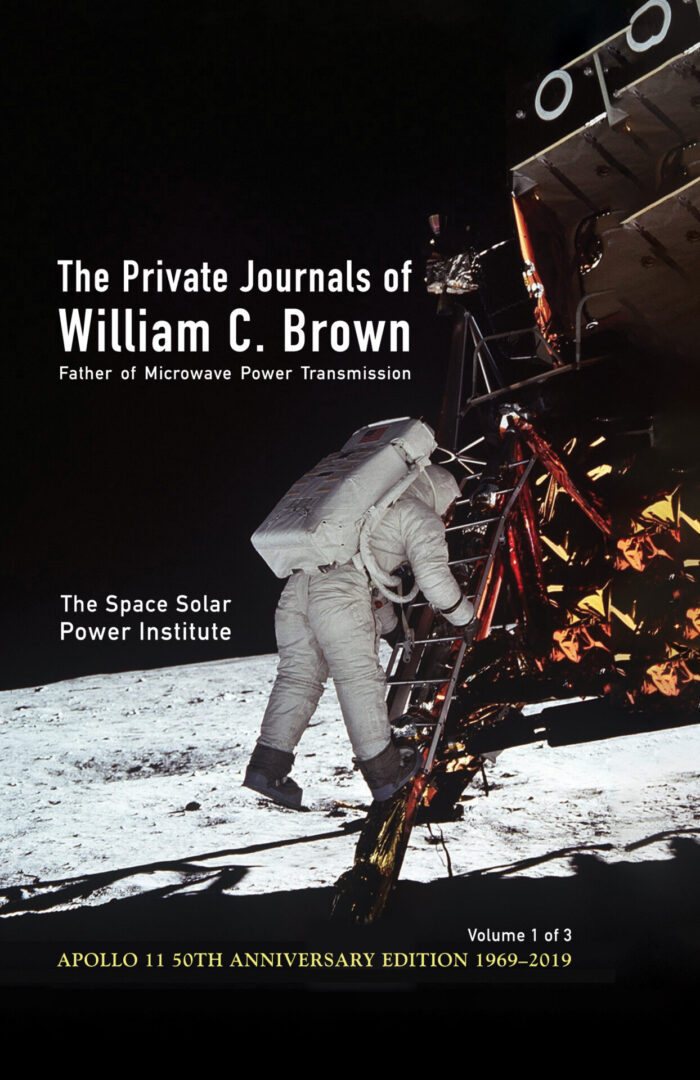The Private Journals of William C. Brown
$93.00
Join Bill Brown, one of the twentieth century’s premier engineers, in this astonishing and intimate autobiography as he invents, demonstrates and pioneers practical Microwave Power Transmission(MPT). Bill’s rectenna provides Space Solar…
Description
Join Bill Brown, one of the twentieth century’s premier engineers, in this astonishing and intimate autobiography as he invents, demonstrates and pioneers practical Microwave Power Transmission(MPT). Bill’s rectenna provides Space Solar Power’s key enabling technology, to continuously, gently and wirelessly beam terawatts of our sun’s immense power from GEO to our groaning electric power grids. SSP can provide unlimited clean reliable energy to Earth, now 85% provided by fossil fuels. On this 50th anniversary of Apollo 11, volume one’s cover celebrates another of Bill’s 50+ landmark patents, his Amplitron, which provided television coverage from the Moon to the world of all the Apollo missions. Share Bill’s family, career and technical ups and downs with this gentle, soft-spoken man, tremendously respected by his peers, with a powerful vision and deep insight into what could be and the technical capability, courageous risk taking, and personal discipline to realize that goal.
For reasons not entirely clear, in the Spring of 1964 something moved William C. Brown to begin keeping a journal to capture his involvement and developments concerning microwave power transmission. He persisted in writing regular entries for the subsequent 35 years, leaving a technological, sociological, and deeply personal treasure trove of information. The result is a poignant and rich exploration not only of the underpinnings of this potentially revolutionary technology, but of the struggles and mindset of its creator. Anyone with even a passing interest in the philosophy of innovation, the origins of wireless power, or the realities of trying to birth new concepts and paradigms will find this work compelling.
The publication of the first of three books, covering Brown’s journal volumes from 1964 to 1975, serves as a mighty initial installment for what promises to be an epic trilogy. Those already familiar with the early history of microwave power transmission and solar power satellites will relish the detailed behind-the-scenes look into the workings and drama of the advancements, difficulties, and setbacks on both technical and programmatic fronts. For newcomers to power beaming technology, the revelation of the advanced nature of the work that occurred in the 1960s and 1970s will be eye-opening. Anyone that pigeonholes engineers as staid, emotionless creatures of logic will see this stereotype obliterated in light of Brown’s outpouring of vulnerability, colorful anecdotes, timeless wisdom, and philosophical musings.
As a record of its time, the account proves a forceful, unfiltered primary source. Female engineers, save one, are completely absent in Brown’s account, as are female executives and female high-ranking government officials. Auto accidents are frequently fatal or life-altering. Disease takes lives quickly. Energy insecurity for society and financial insecurity for the “successful” are prevalent features. The impact of television already exerts its influence where “the artificial and the imagined have become the reality.” Proponents of space solar will see the original sounds and echoes of today’s objections: it’s too expensive; it’s an energy project, not a space project; it’s a space project, not an energy project; there needs to be an incremental development path; and so on.
Brown’s genius and prescience are manifested in numerous ways. He writes about many ideas that have been subsequently rediscovered or that have blossomed in the intervening years, including the use of high frequencies for power beaming, space-to-space power beaming, laser power beaming, wirelessly powering drones and high altitude craft, beamed energy propulsion, radiofrequency identification (RFID), electric cars, and a host of others. His enormous patent portfolio speaks for itself, and the image from the Apollo moon landing on the book’s cover and in his account from July 1969 remind us that the world saw this historic event live, courtesy of his invention of the Amplitron transmitter.
The presentation of Brown’s journal is enhanced by front matter from his colleague John Osepchuk, his daughter Donna Salisbury, and Space Solar Power Institute Executive Director Darel Preble. The book is further augmented through the inclusion of historic photographs, images of hand-written diagrams captured from the journal itself, and a marvelous contribution from Richard Dickinson that fleshes out the story behind the historic power beaming demonstration that occurred at the NASA Goldstone Deep Space Network tracking facility, in which 34 kW of power was sent a mile with a receiver conversion efficiency exceeding 82%.
By turns riveting, intimate, and suspenseful, Brown’s journal is perhaps even more relevant today than when it was originally written. Brown provides a personal window into the realities and tremendous challenges faced by those seeking to break ground with novel technologies, particularly those that cannot easily lay claim to quick returns on venture capital. Brown’s insights into the larger forces and considerations behind technologies and their adoption or abandonment are lucid and show keen sensibility. He paints a high-resolution picture of the pitfalls and travails to be overcome, all adroitly stitched together with glimpses into Brown’s individual, family, and community values.
Contemporary readers may be surprised to learn that even before email, social media, and the shredding of the modern attention span, there still wasn’t time to do it all or to achieve a satisfying work-life balance. Brown frequently characterizes himself as feeling hopelessly behind, overwhelmed, and “submerged,” despite what appear to be robust campaigns of personal fitness and objective accounts featuring surprisingly large amounts of skiing, hiking, yard work, church engagement, and social activities.
Brown’s naked frankness is the root of his ability to produce spellbinding prose. He elucidates the bleakness and euphoria of frustration and success and delves into why when circumstances would seem to call for feelings of triumph, one may still feel pessimism or ennui. Brown’s insatiable curiosity and determination in enrolling in advanced coursework even while seeking to become an instructor himself belie a certain humble relationship with knowledge. Brown’s account shows a mind in near constant ardor, whether in his lab at Raytheon, in his home workshop, or sleepless in the wee hours of the morning.
What are we to make of Brown’s work, 50 years on? While we are starting to slowly see the possible inroads of power beaming into consumer electronics (see Ossia, Energous, PowerCast, Wi-Charge, and others), the grand vision of space solar has yet to be realized. As Steve Fetter wrote in 2004, is it “… An idea whose time will never come?” Or is it merely a decade or two around the corner, as Chinese government investments announced earlier this year seem to suggest? Though this question has yet to be settled, no matter how it is resolved there can be no doubt that William Brown’s journal abundantly shows that he was instrumental in spearheading the foundations of the requisite technology of wireless power transmission.
-Paul Jaffe
Electronics Engineer, Spacecraft Engineering Department/Space Electronics Systems Development
U.S. Naval Research Laboratory
Additional information
| Weight | 3 lbs |
|---|---|
| Dimensions | 9 × 6 × 1.31 in |
| ISBN | 9781631834387 |






Reviews
There are no reviews yet.